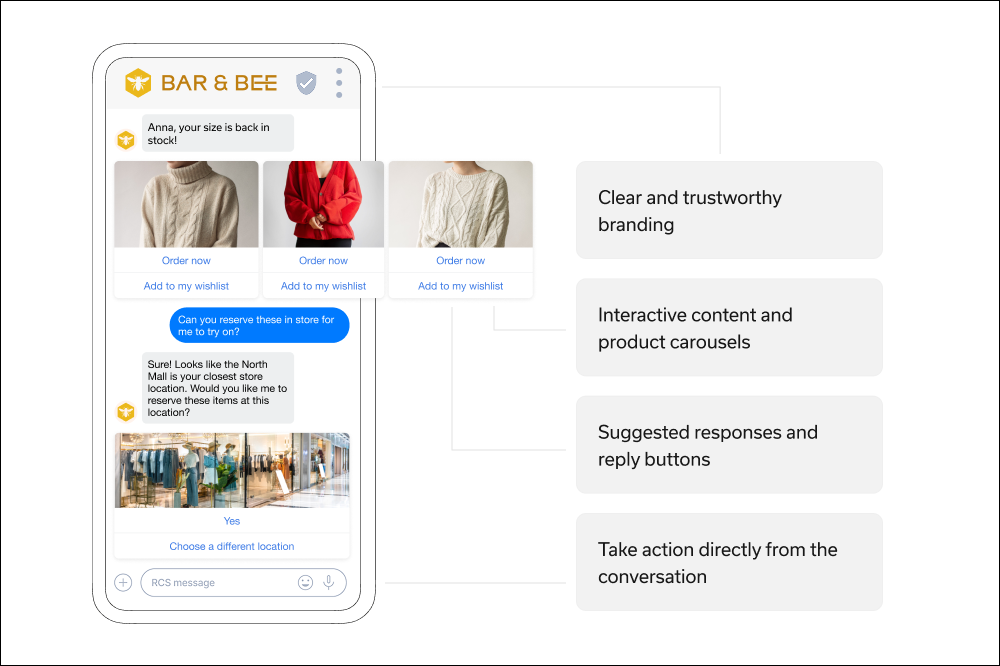RCS is helping brands and marketers move beyond static, one-way mobile messages
Every shopper’s day is a blur of notifications, offers, and alerts. Most messages are forgotten before they’re even read. Mobile has become today’s storefront window — crowded, fast-moving, and easy to scroll past any of the 10,000 or more messages fighting for each person's attention.
The challenge isn’t reach; it’s resonance. Marketers know attention is earned when messages feel timely, relevant, and worth responding to. Yet most mobile touchpoints are still one-way announcements that end as quickly as they appear.
Mobile Rich Communication Services (RCS) changes that dynamic. By turning static notifications into two-way conversations, it gives shoppers a reason to pause, tap, and participate. Whether that’s checking order status, saving a favorite item, or redeeming a reward, these small interactions build a sense of connection that lasts beyond the screen.
From reach to resonance: Why it matters now
SMS still delivers reach and immediacy, yet every message looks the same. Email is great for brand storytelling, but competition for the inbox is fierce. Apps are a way forward, but they are costly, time-intensive to develop, and require extra steps to download.
RCS closes the gap between simple mobile messages and meaningful moments. It combines the reach and familiarity of SMS with the visual impact of an app and the personalization of email. This means verified, media-rich, real-time conversations that happen right inside the phone’s native messaging screen.
There’s no app to build or download, and existing SMS consent carries over automatically. It’s a low-barrier way to deliver app-like experiences that drive measurable results to an audience you already have.
The difference in mobile customer engagement is measurable. Google and MEF have found that RCS messages are 35 times more likely to be read than email. They also deliver up to 7 times more click throughs than SMS, according to Sinch benchmarks. By inviting active participation, a conversation holds attention in a way an announcement never could. As Marigold’s VP of Mobile, Andy Gladwin, noted at DMEXCO, this shift toward dialogue redefines how brands win and keep attention today.
Most shoppers are already equipped to receive richer mobile messages. Today, RCS reaches roughly 70-85% of smartphones in the US, Germany, France, and the UK. In Germany alone, local carrier networks report that about 88% of smartphone users, or around 61 million people, can already receive RCS messages. For context, that’s a broader base than WhatsApp’s 44 million users in the same market (Statista, 2024). And because RCS drives higher engagement at similar send costs, it improves ROI without adding complexity.
Building trust through RCS marketing
Trust starts with knowing who you’re talking to. Every RCS message comes from a verified brand profile, complete with logo, name, and checkmark, giving shoppers visible and trust-inspiring proof that it’s really you. End-to-end encryption and URL previews continue to compound that trust by reducing fraud risk while meeting regional compliance standards like GDPR, UK DPDI, and CPRA. For brands, that means a safer, more reliable way to communicate; for customers, it feels personal and secure.
RCS also opens the door to deeper personalization. When shoppers know a message is genuine, they’re more willing to interact and share their preferences. While SMS, MMS, and push capture first-party data, RCS goes further: its two-way format gathers zero-party data through quick replies and polls. These volunteered insights help brands tailor messages that feel personal across every channel.
With every mobile interaction comes responsibility. Mobile is one of the most personal spaces a brand can enter. With that access comes an obligation to use it wisely. A message that interrupts a shopper’s day better earn its place. If it doesn’t add value, it risks breaking trust. That’s why mobile touchpoints should work as part of a coordinated cross-channel strategy that uses data and personalization to make every interaction helpful and worth the interruption.
How RCS works: From messages to conversations
RCS turns routine alerts into valuable, interactive moments across industries, helping retailers, restaurants, and travel brands reduce friction across the customer journey. You can improve welcome flows, abandoned basket campaigns, or upsell and retention campaigns.
For example, a fashion retailer can send an RCS message when new items arrive in a shopper’s preferred size or style, include a carousel of images, and add buttons to “Reserve in store” or “Add to wishlist.” The shopper interacts directly within their inbox, while the brand collects preference data for future personalization.

More ways to put RCS into action
The real value of RCS comes through in the moments that define shopper trust — when they’re waiting for an order, rushing to catch a flight, or deciding whether to buy again. Here are a few of the ways marketers are already using it:
Deliveries: Failed deliveries cost an average of $17.20 per incident (Statista, 2020). RCS can help reduce missed deliveries by keeping customers informed. After buying a new lamp, a shopper receives a message with a photo of their purchase and a confirmed delivery slot. The chat includes quick actions: “Track delivery,” “Reschedule,” or “Update address.” On delivery day, live updates show when the driver’s nearby, with options like “Ring doorbell” or “Leave in safe place.”
Booking reminders: A travel brand can use RCS to make trip management effortless. Imagine a message that confirms a booking and adds it straight to a traveler’s calendar, or a rich chat with quick-reply options to select seats, check in, or change flights. Travelers can access live updates, book a rental car, or explore destination recommendations, all without leaving their messaging inbox.
Post-purchase engagement and customer care: RCS turns post-purchase support into a loyalty-building experience. A consumer electronics retailer can use RCS to follow up after a laptop purchase with setup tips and buttons to “Watch tutorial,” “View warranty,” or “Contact support.” If a service issue occurs, the same thread delivers real-time updates and a thank-you gesture once resolved.
Smart integrations: Because RCS connects seamlessly with calendar, calls, maps, and other native phone features, it goes beyond messaging and creates experiences that feel seamless and complete. Brands can deliver service, support, and convenience in one effortless flow.
Need assistance? Tap to call. Looking for the nearest store or restaurant? Share your location. Don’t want to miss an appointment? Add it straight to your calendar. All within the same conversation.
A restaurant, for example, can turn what used to be a string of separate touchpoints into a single experience: receive a special offer, choose a nearby location from a carousel, browse the menu, and place an order or call to book a table.
How to get started with RCS
If you don’t have an SMS program yet
Start directly with RCS to capture attention where it matters most. Launch high-value use cases such as delivery updates or appointment reminders. These journeys prove value fast and scale easily across markets.
Optimize and upgrade your existing SMS program
Even without rebuilding your campaigns, you can elevate existing SMS journeys by switching them to RCS. This instantly improves customer experience and trust through verified brand profiles, logos, and secure URL previews.
Audit your existing SMS program and look for opportunities to evolve one-way alerts into interactive exchanges. Add reply buttons, product carousels, or reschedule options to reduce friction and drive faster action, all within your existing workflow.
If you don’t have a mobile app yet
RCS is your chance to deliver an app-like experience natively, without development time or cost. Rich media, verified branding, and interactive elements give shoppers the look and feel of an app inside their messaging inbox.
Every message is a real-time moment
Modern marketing is about turning every notification into a moment of connection. RCS makes those moments count, transforming fleeting updates into more meaningful, two-way conversations. By combining the reach of SMS with the personalization of an email and the interactivity and trust of an app, it turns one-way messaging into engagement that builds confidence, drives repeat shopping, and delivers measurable growth.
Explore how Marigold’s mobile solutions connect with shoppers where it matters most →
FAQs about RCS
What is RCS and why does it matter?
RCS, short for Rich Communication Services, is an upgraded version of SMS that supports verified branding, images, videos, carousels, and reply buttons within the phone’s standard messaging app. It combines the reach of SMS with the interactivity of an app and the personalization of an email, allowing retailers to send engaging, trusted messages without requiring shoppers to download anything new.
What’s the difference between RCS vs SMS?
While RCS shares some traits with SMS, MMS, and push notifications, it serves a different purpose. Push and in-app messages drive traffic to an app or website and collect first-party data based on observed behavior. RCS is bi-directional: consumers can respond directly inside their messaging inbox, letting brands gather zero-party preference data without requiring a download or login.
Do I need new consent for RCS?
No. Existing SMS opt-ins extend automatically to RCS. New opt-ins follow the same transparent processes, compliant with regional regulations. In terms of privacy and security regulations, RCS is carrier-verified, end-to-end encrypted, and compliant with GDPR, CCPA/CPRA, and other frameworks.
Is RCS available in my market and on the devices I’m targeting?
RCS is live across Android and iOS devices and carriers in the US, EMEA (UK, Germany, France, Spain), and APAC, with coverage expanding every quarter. Marigold automatically checks device support and falls back to SMS when needed.
How does RCS connect with loyalty or CRM systems?
Engagement and zero-party data flows through connectors into unified profiles while honoring regional data residency rules. RCS integrates with native mobile apps, including Apple and Google wallets, making it easy to connect RCS messages to loyalty programs.
Do I need an app or major development to use RCS?
No. RCS works natively in the mobile messaging environment, no app build is required for the brand, and no downloads are required for the recipient. For Marigold clients already using SMS, RCS can be activated within your existing SMS workflows swiftly. Speak to your Customer Success Manager for more information.




